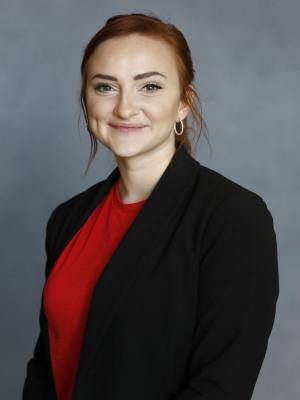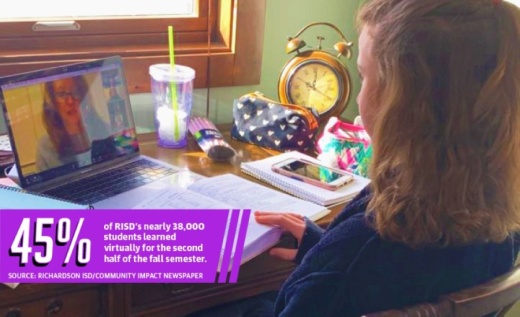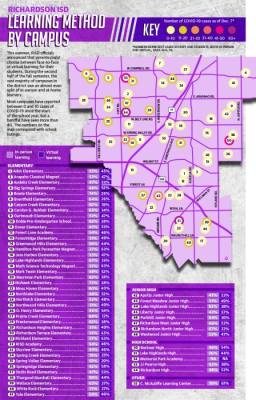Education experts say Hale’s story is not uncommon. Many families across the state have struggled to navigate a semester unlike anything they have experienced before.
“This has been a really hard school year,” Hale said.
Students and their parents are not the only ones who have made big adjustments this year. Richardson ISD officials have had to figure out how to keep schools open while keeping the virus out, Deputy Superintendent Tabitha Branum said.
Over the summer, school leaders were forced to reformat learning structures to educate students both from home and in the classroom. They also had to ensure students who fell behind in the spring were given the resources to catch up, and a major decline in enrollment left staff with the difficult task of tracking down thousands of students, according to the district.
Despite all the challenges, district officials said they feel optimistic about how the semester has gone.
“That’s not to say that we think everything we’ve done is absolutely perfect,” Branum said. “We’ve adjusted [COVID-19 guidelines and precautions] as we’ve gone along to improve based on feedback.”
Safety precautions
To curb potential spread of the virus, the district put a mandatory mask requirement in place for students and staff.
Students in grades 3-12 and all staff are expected to wear face coverings at all times while on campus, except while eating or drinking, according to district policy. Students in grades pre-K-2 are required to wear face coverings in halls, common areas and during arrival and dismissal, and they are encouraged to wear face coverings in classrooms. The district also installed desk shields in all classrooms, libraries and cafeterias.
“Regardless of what health expert you listen to, they will say the single most important risk mitigation strategy ... is to wear masks,” Branum said.
These precautions have helped control the number of confirmed cases in the district, Branum said. Between Aug. 19 and Dec. 7, just 1.41% of students and 2.97% of staff tested positive for the virus, according to the district’s dashboard. This is similar to neighboring Plano ISD, which showed that 1.12% of students and 3.62% of staff had confirmed cases of the virus within the same time frame.
The district has spent just over $2.4 million on protective personal equipment, and the state pitched in another $394,000, Chief Financial Officer David Pate said.
The district launched a program Dec. 2 in partnership with the Texas Education Agency that provides rapid tests for faculty and staff. Students who show symptoms while at school can get tested with parental consent, Assistant Superintendent of Administrative Services Brenda Payne said.
The tests are between 97%-98%, according to the district. In other words, a negative result does not ensure the absence of the virus, Payne said. Even if people test negative, they will still be asked to quarantine in case they later test positive.
Precautions taken by school districts in the North Texas area seem to be effective overall, said Missy Bender, regional advocacy director for Raise Your Hand Texas, a nonprofit focused on public education. Still, the changes have been draining for everyone involved, she said.
“[School staff] are working so hard that they are just exhausted,” Bender said. “I’m hopeful that parents and community members will highly value the commitment that educators have to the children.”
Remediation efforts
When schools shifted to virtual learning for all students in the spring, district officials immediately began preparing for what they called the “COVID slide,” or a learning regression caused by the pandemic.
Richardson ISD students in kindergarten through 10th grade were assessed a few weeks into the fall semester on math, science and reading, Branum said.
Results found students had regressed more in math than in reading. The data also showed that the equity gap among students of different socioeconomic classes had widened because of the shift to online learning, Branum said.
“Not only did we see that [equity gap] sustained itself, but in some areas, it continued to grow,” she said.
To close this gap and to help all students catch up, the district implemented several different intervention programs, including a Saturday literacy school in which specialist teachers help students work on skills they lack. Educators have worked tirelessly to close the achievement gap and have built intervention time into their daily curriculum, Branum said.
“We have amazing teachers who are constantly assessing their students every day, identifying their strengths and identifying those areas of a gap,” she said.
Though intervention began early in the semester, results will not be known until the district conducts its midyear assessments in January.
Some school districts called on the Texas Education Agency to cancel the State of Texas Assessments of Academic Readiness, or STAAR tests, as it did last spring, but RISD was not among them, Branum said. On Dec. 10, the agency announced it will still administer the STAAR test, although test results will not be used for accountability purposes.
“We are not opposed to giving the STAAR assessment,” she said. “We do not believe that there should be high stakes accountability attached to it.”
Finding missing students
Year over year, enrollment is down in the district by more than 1,500 students. Officials have expressed concern not only about a resulting loss in state funding but also about the whereabouts of missing students.
The district had 37,385 students enrolled as of Sept. 14, the 17th day of school for the fall semester, Payne said at a Sept. 21 board meeting. This is 2,105 fewer students than the district had enrolled on the 17th day of school in 2019, she said. As of Nov. 16, district enrollment had increased to 37,797 students.
The state distributes funding based on enrollment and attendance, Chief Financial Officer David Pate said. For each student, the district receives about $7,000 and could receive more based on special circumstances, such as if the student is economically disadvantaged or dyslexic. TEA officials announced in October that districts would still receive anticipated funding for the first half of the 2020-21 school year, regardless of enrollment.
District officials said they do not yet know whether this exception will be extended into the spring, which means the budget for the upcoming semester could still be affected, Branum said.
Over the last several months, members of the RISD Student Services Department have attempted to track down missing students by making phone calls and knocking on doors, Payne said. The goal is to identify why students are no longer enrolled as well as to provide solutions, such as technology, that could help them re-enroll.
The district has found that many parents pulled their students from school because of safety concerns, Payne said. Some students have become caretakers for younger siblings while parents work, and others have become the primary wage earner for their families, Branum said.
“We continue to connect with those parents and keep that relationship going so that when they feel like they’re in a place that they could re-enroll, ... they know that we’re ready to have them back,” Payne said.
Looking forward
Heading into the spring semester, parent Alisa Woods said she would like to see policy adjustments from the district. She said she intended to send her 11th-grade daughter to JJ Pearce High School in person but opted instead for virtual classes after learning that anyone in close contact with someone who has the virus must quarantine for 14 days.
“My frustration with the contact tracing is that I just don’t agree with sending healthy kids home constantly,” she said.
In a Nov. 19 YouTube video, Superintendent Jeannie Stone acknowledged frustrations surrounding the district’s quarantine policy and said the policy was under evaluation.
But as positive cases in schools across Texas increased through the end of the semester, it became more important than ever to take precautions that would protect students and staff, Stone said.
“To say that teachers and our staff are concerned is an understatement,” she said.







